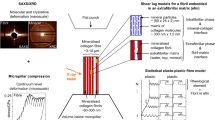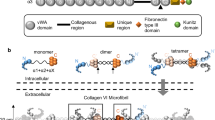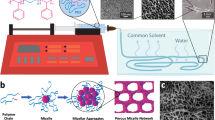Abstract
Collagen constitutes one third of the human proteome, providing mechanical stability, elasticity and strength to connective tissues. Collagen is also the dominating material in the extracellular matrix (ECM) and is thus crucial for cell differentiation, growth and pathology. However, fundamental questions remain with respect to the origin of the unique mechanical properties of collagenous tissues, and in particular its stiffness, extensibility and nonlinear mechanical response. By using x-ray diffraction data of a collagen fibril reported by Orgel et al. (Proceedings of the National Academy of Sciences USA, 2006) in combination with protein structure identification methods, here we present an experimentally validated model of the nanomechanics of a collagen microfibril that incorporates the full biochemical details of the amino acid sequence of the constituting molecules. We report the analysis of its mechanical properties under different levels of stress and solvent conditions, using a full-atomistic force field including explicit water solvent. Mechanical testing of hydrated collagen microfibrils yields a Young’s modulus of ≈300 MPa at small and ≈1.2 GPa at larger deformation in excess of 10% strain, in excellent agreement with experimental data. Dehydrated, dry collagen microfibrils show a significantly increased Young’s modulus of ≈1.8 to 2.25 GPa (or ≈6.75 times the modulus in the wet state) owing to a much tighter molecular packing, in good agreement with experimental measurements (where an increase of the modulus by ≈9 times was found). Our model demonstrates that the unique mechanical properties of collagen microfibrils can be explained based on their hierarchical structure, where deformation is mediated through mechanisms that operate at different hierarchical levels. Key mechanisms involve straightening of initially disordered and helically twisted molecules at small strains, followed by axial stretching of molecules, and eventual molecular uncoiling at extreme deformation. These mechanisms explain the striking difference of the modulus of collagen fibrils compared with single molecules, which is found in the range of 4.8±2 GPa or ≈10-20 times greater. These findings corroborate the notion that collagen tissue properties are highly scale dependent and nonlinear elastic, an issue that must be considered in the development of models that describe the interaction of cells with collagen in the extracellular matrix. A key impact the atomistic model of collagen microfibril mechanics reported here is that it enables the bottom-up elucidation of structure-property relationships in the broader class of collagen materials such as tendon or bone, including studies in the context of genetic disease where the incorporation of biochemical, genetic details in material models of connective tissue is essential.
Similar content being viewed by others
Article PDF
Author information
Authors and Affiliations
Corresponding author
Rights and permissions
About this article
Cite this article
Gautieri, A., Vesentini, S., Redaelli , A. et al. Hierarchical nanomechanics of collagen microfibrils . Nat Prec (2010). https://doi.org/10.1038/npre.2010.4995.1
Received:
Accepted:
Published:
DOI: https://doi.org/10.1038/npre.2010.4995.1



